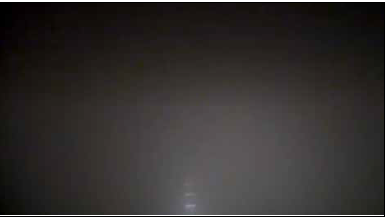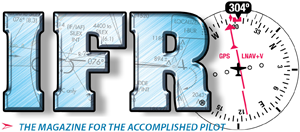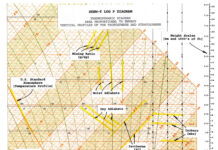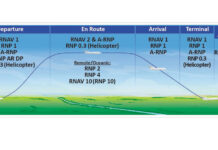Category I ILS approaches, long our low-weather mainstay, offer us minimums as low as 200 feet above the touchdown zone with RVR 1800 feet or higher. That’s low, but as it develops, not as low as you can go. CAT II approach approval opens about 160 public CAT II approaches to GA, easing access to bigger airports. Descents can be as low as 100 feet HAT/ DH with RVR 1200 or more. Approach category A aircraft flying approach speeds of 90 knots or less are eligible, including helicopters. In the past, CAT II operations were individually authorized by waiver under legal exemptions dating back to 1989. Those casual days are over. Since regulators are supposed to regulate, in January 2020, the FAA announced a formal CAT II approval process to its cadre of Flight Standards inspectors. Here’s a summary of navigating the approval process.
The Backstory
Also in the past, the FAA decided it could lower height above touchdown (HAT) and visibility values for Category A aircraft operators based on demonstrated pilot skill and the precision of aircraft and ground-based navigation equipment. To this end, the FAA approved by waiver reduced ILS CAT I minimums for individual operators flying designated approaches.

Formal CAT II authorization was the next logical step. Deeper in application and broader in scope, approved pilots and aircraft can now fly any CAT II approach in the U.S. FAA Order 8900.1 Change 690, under the lengthy title “Approval of Small Category A Aircraft for Category II Operations—Part 91,” details how to go about it. Even as a Cat II approach is not for the faint of heart, neither is the process for earning approval. If it were easy, would you want to fly it?
By the Numbers
The legal framework begins with §91.193, which permits deviations to the Category II requirements in §91.189, §91.191, and §91.205(f). Deviation from §91.189, Category II and III operations, is necessary because it calls for a second in command. As modified, if an aircraft type design does not require a SIC, none is needed. CAT II operation requires an information manual per §91.191. The order permits deviation to this rule but isn’t specific. You might need relief from subsection (f) requiring a copy kept at your “principal base of operations.” The equipment required for CAT II approaches is in §91.205(f). Subsection (1) simply references the IFR equipment and radio gear we already have. Subsection (2) refers us to CAT II Operations in Part 91 Appendix A. There we discover in Section 2 that duplication of the instruments and radios referenced in §91.205(f)(1) is not required.
Order Overview
The order is not manufacturer-specific, nor does it purport to be all-inclusive. It walks a FSDO Aviation Safety Inspector (ASI), and us indirectly, through the approval process. The ASI’s task is to decide whether an operator has acceptable procedures to conduct safe instrument approaches to CAT II minimums, meaning a DH below 200 feet. Approval does not allow a pilot to reduce published CAT I minimums. Earning CAT II authorization isn’t easy. Beyond the ASI, the Flight Technologies and Procedures Division must also approve. FAA Operations, Avionics and Airworthiness units, and the Aircraft Maintenance Division are also involved. Successful completion requires acceptance of the operator’s proposed CAT II procedures manual, including a satisfactory in-flight equipment evaluation. Ultimately, a Principal Operations Inspector issues a Letter of Authorization (or a denial).
Start the Ball Rolling
Write a formal letter of intent to the responsible FSDO requesting approval to conduct CAT II operations. Include specifics such as your flying experience, type of aircraft, avionics on board, and your maintenance and inspection programs. Review the regulations above and request exemptions accordingly. In reply, an inspector will advise you of the requirements for approval in the form of an application package. The package starts with you. You must meet the recent flight experience requirements in §61.57 for takeoffs and landings and IFR currency, and §61.67, Category II pilot authorization requirements. It’s convenient to seek CAT II authorization and conduct the required aircraft evaluation at the same time. The FAA can only issue a Letter of Approval (LOA) to a pilot who meets CAT II certification and recency requirements at its time of issuance. Part 91 Appendix A, Section 1(b) offers specifics as to content. The manual has three sections: aircraft identification, maintenance program details, and flight procedures. There is provision for a one-time evaluation program for equipment not already holding a CAT II type or supplemental type certificate. The manual applies to one aircraft, identified by its make, model, N-number, and serial number.
Maintenance
Propose your maintenance program as specified in Part 91, Appendix A, Section 4. Inspection types include periodic bench and flight checks. Each CAT II instrument and piece of equipment must be inspected every three months. You may alternate between a maintenance shop check and a functional flight check by a pilot with CAT II authorization. Spell out procedures for each type of check plus how and where to record the results. A shop must report any defects to the pilot. A certificated repair station must perform annual bench checks including an altimeter and static system test. A bench check means to remove an instrument or piece of equipment, say an ILS receiver, visually inspect it, and repair, replace or calibrate it as necessary. After one 12-month maintenance cycle, you may request an extension if the equipment performance justifies it.
Extra CAT II Gear
Remember your marker beacon receiver? It gains new importance because it must provide aural and visual indications of the outer and middle marker for approaches down to 150 feet DH. For operations down to 100 feet, it must identify the inner marker. Alternatively, use a radio altimeter. Absent a radio altimeter (RA), the pressure altimeter requires a correction card to account for scale error. Your instrument shop should provide that. The January AIM update notes that most MMs have been decommissioned and are not operationally required. The update was issued three days after this order was published. Moreover, an informal survey of CAT II approaches revealed that none called for an OM or MM. IMs were spotty. You’ll need an RA to descend below 150 feet with no IM. The inspector might need to resolve the order’s dependence on markers. The communication system must not affect the ILS localizer or glideslope receiver. Warning flags and the dreaded red X on your primary flight display are sufficient. Radio altimeter system faults must also give warning. You must have an alternate static pressure source and a heated pitot tube.
Flight Procedures
The order requests procedures and instructions relating to a 10-item list including DH, use of RVR, and missed approaches. Since it goes into no depth, ask the inspector what is required. Items worthy of discussion are below. The order mentions the decision region, the space between the middle marker or final approach fix, and DH. The manual must specify the maximum permissible deviation of the primary ILS indicator in that region. Specify the minimum altitude for use with the autopilot. Discuss instrument and equipment failure warning systems aboard, as well as procedures for handling instrument failure, and use of the radio altimeter if equipped. Of course, additional procedures, instructions, and limitations can be required by the inspector.
Equipment Evaluation
The main focus of the evaluation is to qualify a flight control guidance system (FCGS) for CAT II. If not already type-certificated, approval by evaluation should be part of the application for approval of the Category II manual. An FCGS is either a flight director or an “automatic approach coupler,” an autopilot. The flight director must display computed steering information to track the localizer and provide either pitch commands or raw glideslope information. The approach coupler must provide at least automatic steering on the localizer. Accordingly, you can hand-fly a CAT II approach with the flight director or coupled to the autopilot with or without glideslope coupling. You should merge information from the evaluation program into operational procedures and techniques in your CAT II manual. Present any requests for deviation to the FSDO, which then coordinates with the Flight Technologies and Procedures Division. The order refers to the procedures and requirements in Part 91 Appendix A, Section 3(e), to conduct an evaluation program. Alas, the order’s assessment rules don’t match those in Appendix A. Furthermore, both evaluations say “altimeters,” but the regulations and the Letter of Authorization require just one. The evaluation process derives from the FAA order. An FAA Operations inspector observes five approaches and records each outcome using the order’s Approach Evaluation form, which can be amended to suit. If successful, the demonstration is satisfactory. Otherwise, nine out of ten approaches must be successful. Failure prompts a disapproved application.
Successful Approaches
A successful approach includes all of the following: Deviation from the glideslope after passing the outer marker must not exceed half scale. Beyond the middle marker, there should be no unusual roughness or excessive attitude changes. At 100 feet DH, the indicated airspeed and heading should be suitable for a normal flare and landing. The cockpit should be within the lateral confines of the runway and track in a direction that keeps it there. After disconnecting a coupled approach, the AP must hand the pilot an aircraft sufficiently in trim to continue a normal approach and landing. Evaluations are conducted in simulated IMC by prior arrangement with ATC. Ask them to ensure that no vehicles or aircraft will move into the ILS critical area to prevent wobbly ILS signals during the test. If the inspector sees an outside condition that causes an unsatisfactory approach, s/he can disregard it. It’s unnecessary to conduct the approaches on a CAT II ILS because many CAT I ILS facilities meet CAT II standards. The difference is that CAT I monitors have wider tolerances than CAT II facilities. This agreeable circumstance is a break because there are 1250 CAT I approaches versus 159 CAT II approaches. Every FCGS, which we equate to a flight management system, has flags, lights, aural warnings, and other displays to inform us of normal and abnormal operation. The inspector evaluates them to assure they provide the pilot with information adequate for CAT II operation. For the evaluation, you needn’t meet the CAT II authorization requirements in §61.67, but you can earn it during the ride.
Application Package
Once you submit your application package, what happens? Initially, FAA Operations, Airworthiness, and Avionics inspectors review it for completeness and verify that the aircraft and avionics are equipped as required. If the manual is unsatisfactory, the FSDO will contact you and explain what needs correction. They will include a date by which you must submit a corrected manual. If you miss it, expect a letter of disapproval. On a happier note, if the manual is acceptable, the FSDO forwards it to the Flight Technologies and Procedures Division. Their concurrence is required for all small Category A aircraft, CAT II ILS authorizations. The LOA will state that the provisions of §91.189 apply in full, except for the second-in-command. It will list the required equipment. The minimum for ILS approaches to CAT II runways is 100 feet DH/RVR 1200, regardless of published lower minimums. Passengers or property cannot be carried for compensation or hire. The LOA requires an operational check of the ILS equipment within the last 15 flight hours and 15 calendar days before flight. It can be via ramp test equipment, a functional flight check by a CAT II-authorized pilot, or by an actual approach. Record these in the aircraft logbook or aircraft maintenance record as appropriate.
Looking Ahead
Changes to the FCGS make, model or design must be approved. Revise your manual regularly. Periodic renewal of the LOA may be required. CAT II authorization is a feather in your cap and confers rare bragging rights. But be forewarned: You’ll have to earn them.






I checked a few CAT I and CAT II approaches near me and they all require HUD or Autoland per their approach plates. Are there enough CAT II approaches out there without this restriction? Otherwise, this article should likely mention that additional equipment as practically required.